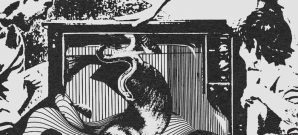 Sonic Youth’s expanded double-disc re-release, Daydream Nation (Deluxe Edition), is an amazing record with unfortunately less-than-amazing extras. New York’s seminal alt-punk icons have been around for 25 years, but it’s questionable whether anything in their extensive discography is as ‘seminal’ as 1988’s Daydream Nation. It was the crossing point between their noise-punk 80’s and alt-grunge 90’s, while simultaneously being perhaps the highpoint of both. Yet the bonus disc feels entirely unnecessary, with live versions of Nation tracks that don’t really stand out from the originals, and some nice, but hardly essential, covers from the same time period.
Sonic Youth’s expanded double-disc re-release, Daydream Nation (Deluxe Edition), is an amazing record with unfortunately less-than-amazing extras. New York’s seminal alt-punk icons have been around for 25 years, but it’s questionable whether anything in their extensive discography is as ‘seminal’ as 1988’s Daydream Nation. It was the crossing point between their noise-punk 80’s and alt-grunge 90’s, while simultaneously being perhaps the highpoint of both. Yet the bonus disc feels entirely unnecessary, with live versions of Nation tracks that don’t really stand out from the originals, and some nice, but hardly essential, covers from the same time period.
There’s no better opening to the late eighties/early nineties alt/punk/grunge explosion that the first guitar chords of Daydream Nation opener “Teenage Riot”. Melodic, rocking, and even catchy, “Riot”, and the incredible driving guitars of the following “Silver Rocket”, maybe best encapsulate singer/guitarist Thurston Moore’s excellence. That’s followed up by maybe the most quintessential ‘Kim’ song, the dark, haunting, extended sonic rock of singer/bassist/guitarist Kim Gordon’s “The Sprawl”. And then, only two songs later, comes the most quintessential ‘Lee’ song, the moving, interesting, creative, and all-around awesome number from singer/guitarist Lee Renaldo, “Eric’s Trip”. And the rest of Daydream Nation is littered with classic tracks, including Renaldo’s more matter-of-fact, in-your-face “Hey Joni”, the almost-quintessential ‘Kim song about men objectifying women’, “Kissability” (only exceeded by the hit single off their subsequent record, 1990’s “Kool Thing” – and that had Chuck D…), the epic “Trilogy” trio, and “Providence”, a Walkman-recorded piano solo put together with the sound of amp overheating, and a phone message from a Providence, Rhode Island payphone.
But if that was all you were after, you could just stick to DGC’s 1993 re-release of Daydream Nation (the original 1988 release had been poorly handled by their then-label Enigma, which prompted Sonic Youth to leave Enigma – but it also got them signed by now-DreamWorks music mogul David Geffen’s DGC). The point of a ‘deluxe edition’ is the extra tracks, but unfortunately, it seemed like DGC had to scramble to find any. There’s only one alternate version of a Nation track, Renaldo’s home demo of “Eric’s Trip”. Nice and pretty, this really different take on the song is what one looks for in an extra, and there should have been more like of them.
Other than the addition of that demo, the first disc is exclusively Daydream Nation (“Trilogy” was, thankfully, broken up into three tracks this time), with everything else extra the second one. All but four of the disc’s nineteen pieces are live recordings of Nation songs, with at least one for every single song. But for the most part, the live recordings add little to the Nation numbers, with a few outright worse, including those of standout Nation songs “Silver Rocket”, “The Sprawl”, and “Kissability”. Only the thumping “Candle” was particularly improved live, as the slower number becomes more anthemistic. Maybe it’s just because one has become used to the excellence Sonic Youth delivers in concert these days (QRO review), but the live material from their ‘88-’89 Nation tour doesn’t feel that significant.
Deluxe Edition ends with four covers, all culled from multiple artist releases of the same time. The cover of Mudhoney’s top single “Touch Me I’m Sick” was from a split 7” that Sonic Youth released with them in 1989, and while the Southern-fried grunge is good, “Sick” also clearly shows how much better Sonic Youth are than Mudhoney. The other three songs all come from tribute compilations to sixties/seventies musicians. Psychedelic rock meets noise rock with The Beatles’ “Within You Without You”, perhaps too much in that direction, but worthwhile as an extra. The sort of ‘dark rock’ of Neil Young’s “Computer Age” is a bit unexpected, coming from Youth meeting Young, but is a cool, good end result that lets you know why Neil Young was so popular among grunge-era rockers like Sonic Youth and Nirvana. And in a nice companion to the penultimate “Computer Age”, psych-folk meets noise-rock with finisher “Electricity” by Captain Beefheart, as the cover of the weird-even-for-the-sixties Beefheart is indeed weird, but not overly so.
2007 seemed like a good time to issue an expanded re-release of Daydream Nation. Sonic Youth is playing the record, in its entirety, at handful of dates in America and Europe, including the Pitchfork Music Festival (QRO Festival Guide) and at Brooklyn’s McCarren Park Pool (QRO Calendar listing). And just last year, Daydream Nation was among the fifty recordings picked by The Library of Congress to be added to the National Recording Registry. But Nation isn’t a record that really needs to be expanded, and even if it did, these extras wouldn’t do the job. Daydream Nation’s excellence is timeless, and needs nothing more.


















